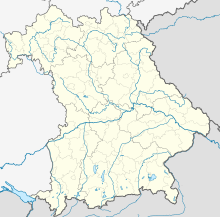Battle of the Alte Veste
You can help expand this article with text translated from the corresponding article in German. (November 2019) Click [show] for important translation instructions.
|
This article needs additional citations for verification. (September 2008) |
| Battle of Alte Veste | |
|---|---|
| Part of the ) | |
| Result | Imperial victory |
30,011 infantry in 37 regiments and 306 companies
15,419 cavalry in 39 regiments and 263+ companies[2]
The Battle of the Alte Veste was a significant battle of the Thirty Years' War in which Gustavus Adolphus' attacking forces were defeated by Wallenstein's entrenched troops.[4]
Background
In the late summer of 1632 the army of Swedish King
The Imperial Army's ranks swelled as Wallenstein moved to stop the Swedes' advance at Nuremberg. Repeatedly, Gustavus formed for battle and challenged Wallenstein to come out of his fortified camp, but was refused. As the supply situation continued to worsen, the impetuous King grew desperate.
Battle
Gustavus Adolphus attacked the Imperial camp at the Alte Veste (or "Old Fortress")—a derelict castle situated atop a wooded hill. Its ownership would then allow the Swedish guns to dominate the Imperial camp. The Imperials were prepared with trenches and an

Result
The Swedes had been defeated. The Commander of the Swedish artillery,
Citations
- ^ Clodfelter 2017, p. 40.
- ^ "Archived copy" (PDF). Archived from the original (PDF) on 2016-04-12. Retrieved 2016-03-07.
{{cite web}}: CS1 maint: archived copy as title (link) - ^ a b Wilson 2018, p. 34.
- ^ Clodfelter 2017, p. 37.
References
- Clodfelter, M. (2017). Warfare and Armed Conflicts: A Statistical Encyclopedia of Casualty and Other Figures, 1492–2015 (4th ed.). Jefferson, North Carolina: McFarland. ISBN 978-0786474707.
- Wilson, Peter H. (2009). Europe's Tragedy: A History of the Thirty Years War. Allen Lane. ISBN 978-0-7139-9592-3.
- Wilson, Peter H. (2018). Lützen: Great Battles Series. Oxford: Oxford University Press. ISBN 978-0199642540.
External links
 Media related to Battle of the Alte Veste at Wikimedia Commons
Media related to Battle of the Alte Veste at Wikimedia Commons


